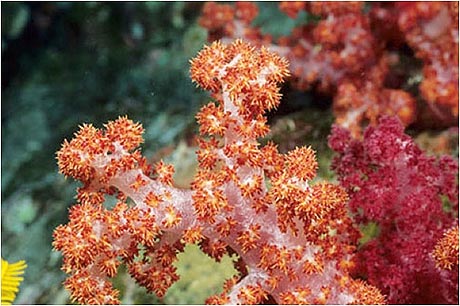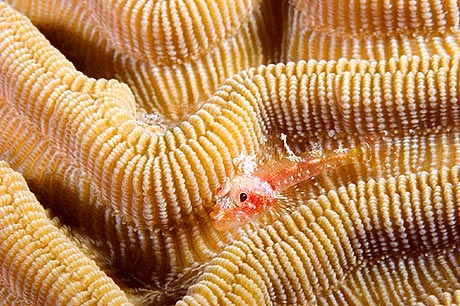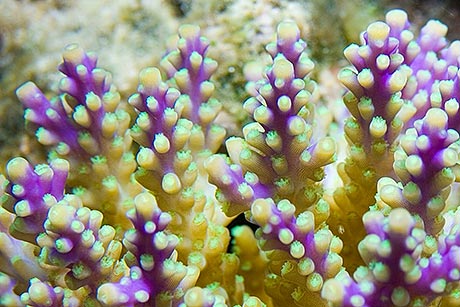1943
UM Marine Lab founded by Dr. F.G. Walton Smith is singled out in Science by Dr. Thomas Barbour of Harvard University, he says: “…to all American biologists interested in opportunities to conduct investigations in marine zoology or physiology and assorted disciplines, here is the answer to prayer.”
1948
Dr. F.G. Walton Smith authors a book on reef corals featuring photos by Dr. Fredrick M. Bayer. The book is the first-ever book published by the University of Miami Press and is also a groundbreaking guide to corals in the western Atlantic, their taxonomy and guides to identification and living habits.
1951
Perceiving a need for a scientific journal dedicated to the biology of tropical and subtropical waters, Dr. Walton Smith launches the Bulletin of Marine Science of the Gulf and Caribbean. Dr. Hilary Moore is the publication’s first editor, and a section in each issue is dedicated to papers on coral reefs.
1953
Papers by Dr. Robert Ginsburg on two common features of coral seas introduced new directions for coral research: intertidal erosion of limestone and the formation of beach rock.
1956
A seminal publication by Dr. Robert Ginsburg reporting the origins of coral reef sands in Florida document how their composition reflects environments and stimulated further research in the area.
1957
Dr. Gilbert L. Voss proposes that an extensive area of the Hawk Channel, bank and coral reefs seaward of Key Largo be preserved. His efforts and strong local and statewide support, including support from The Miami Herald, resulted in the establishment of John Pennekamp Coral Reef State Park in March 1960.
1958
Dr. Walter Starck begins ten-year study of coral reefs in the Florida Keys. Over 20,000 scientific specimens are collected – the study records what is still the greatest number of fishes known from any single locale in the New World. Of the 517 species, sixty had never before been found in U.S. waters before and 19 were previously unknown.
1961
First research on Florida’s unique inshore lagoonal patch reefs in the Florida Reef Tract conducted by Drs. Gilbert Voss and Frederick Bayer via a three-year grant from the National Geographic Society.
1962
Hydrophones and an underwater TV camera on a reef one mile off the west bank of Bimini, Bahamas is installed to record animal sounds. The system allows the playback of sounds to the reef, which marks the beginning of the bioacoustics program at the Rosenstiel School.
1964
Drs. Walter Starck and Robert E. Schroeder begin the first extensive exploration of coral reefs at night. Their work is featured in the January 1964 issue of National Geographic and spark interest in the study of the nocturnal habits of fish and invertebrates on the reef.
1964

Dr. Richard Robins begins pioneering work on feeding mechanisms and feeding habits of coral reef fishes on a number of Florida reefs, through a grant from the NSF.
1970-1973
UM scientists discover a new class of reefs in Bermuda that are constructed by coralline algae and sessile gastropods and rapidly thoroughly lithified by precipitation of calcium carbonate from sea water.
1976-1980
Drs. Robert Ginsburg and Noel James explore to 400 meters on the reef wall in Belize, using a submersible, and discover new luxurious deep reef zone and pervasive lithification that help explain why the wall is nearly vertical.
1977
3rd International Coral Reef Symposium takes place at the University of Miami’s Coral Gables campus; Dr. Robert Ginsburg is chair of the Organizing Committee. Results from the event include two volumes of Proceedings. ICRS papers, posters and lectures inspire a series of subsequent drilling campaigns in the Caribbean and Great Barrier Reef.
First regional maps of coral reef habitats in South Florida unveiled at the ICRS by Dr. Donald Marzalak of the University of Miami’s Marine Geology and Geophysics division.
1978
Dr. Cesare Emiliani and colleagues publish a paper in Nature about carbon and oxygen isotope analysis through a 30-year study of the growth of Montastraea annularis, a milestone in the study of Isotopic Paleotemperatures and Geochronology.
1980
Core borings by Drs. David Beach and Robert Ginsburg reveal the role of reefs in the development of Great Bahama Bank.
1981
The International Society for Coral Reefs is founded in Cambridge England by a committee headed by Dr. David Stoddart. One of the committee members is Dr Peter K. Swart.
1982
Early applications of remote sensing (seismic profiles) in coral reef science by Drs. Dong Ryong Choi and Robert Ginsburg establish the riverine foundations of reefs in the Belize Barrier Reef Lagoon.
1983
Dr. Gilbert L. Voss provides an environmental assessment of the John Pennekamp Coral Reef State Park and Key Largo Coral Reef Marine Sanctuary as a baseline study for invertebrates and algae of the areas. Companion fish study completed by Drs. Scott Bannerot and Michael Schmale, also from the University of Miami.
1983
A massive die off of long-spined black sea urchin, Diadema antillarumin the Atlantic-Caribbean regions sparks Dr. Alina Szmant and Tom Capo at UM’s Experimental Hatchery to begin to culture and raise these animals to try and restore these important algal grazers to local reefs.
1983
Dr Peter K Swart publishes review paper in Earth Science Reviews on the Carbon and Oxyhen isotopic composition of coral skeletons
1988-1989
Discovery of episodic reef development in core borings controlled by sea level changes shaped Great Bahama Bank by UM coral reef scientists.
1993
Dr. Walton Smith among a group of scientists who publish “Oil on troubled waters: impacts of the Gulf War on coral reefs,” after 6–8 million barrels of oil are released into the marine environment and a total of 1.12 billion barrels are burned in Kuwaiti oil fields during the war. The team concludes that corals in Saudi Arabia survived the largest oil spill on record remarkably unscathed.
1994

UM'’'s Drs. Warzeski, Cunningham and Ginsburg use a combination of seismic profiles and core borings to reveal that the northern Florida Reef Tract has a foundation of siliceous sands derived from the Appalachian Mountains.
1994
Article on the damage and recovery of coral reefs after Hurricane Andrew by Drs. Peggy Fong and Diego Lirman published in National Geographic Research and Exploration.
1996
ICRS in Panama City, Panama features the work of Dr. Alina Szmant on nutrient runoff from human population centers, which affect coral proliferation and result in a trophic imbalance in the Florida Reef Tract. Her study concludes that naturally occurring upwellings may actually supply the Florida reef tract with up to 40 times more nutrients than all human-caused sources identified by the EPA at the time.
1997
First International Year of the Reef organized by Rosenstiel School faculty members raised public awareness of coral reefs, their resources and their fragile state.
1999
A study by Dr. Peter Glynn on the eastern Pacific coral reef demonstrates that corals surviving the strong 1997-98 El Ni–o warming event harbor resistant photo-symbiotic algae, which raises the possibility that coral species with specific types of symbiotic algae will be better able to resist high-temperature global change.
2001
Status of coral reefs in the Western Atlantic marks the first regional assessment of reef community conditions using a newly-developed standard method.
2003
UM launches its Center for Southeastern Tropical Advanced Remote Sensing (CSTARS), a state-of-the-art facility that provides low earth-orbiting satellite images, a key tool for mapping and evaluating coral reefs and coastal areas in the Gulf of Mexico, Southeastern United States, northern South America, Central America and the Caribbean Basin.
2004
The International Society for Coral Reefs announces that the 2008 meeting will be held in South Florida. Dr. Ginsburg, Swart, and McManus are appointed to the local organizing committee. Dr. Baker is appointed to the science committee.
2005
Dr. Iliana B. Baums helped to develop genetic analyses to identify two geographic families of a major reef building Elkhorn corals, not interacting between the western and eastern Caribbean region.
2005

Dr. Swarts work on the nitrogen isotopic composition of corals in the Florida Keys, published in Limnology and Oceanography, supports the contention that anthropogenic sources of pollution are not responsible for the current decline in coral populations.
2005
UM’s Dr. Chris Langdon and Dr. Marlin Atkinson from the Hawaii Institute of Marine Biology, discover that skeletal growth, photosynthesis of guest algae, and the normally mutually beneficial relationship between guest algae and host coral, are all affected when CO2 conditions similar to those expected in the next 50 - 100 years are simulated in the lab.
2005
An autonomous underwater vehicle (AUV) using advance sonar is used for the first time in mapping deepwater reefs by Drs. Mark Grasmueck and Gregor Eberli, who discover major mounds of deep coral in the Straits of Florida
2005
Drs. Robert Cowen, Claire Paris and Ashwanth Srinivasan create a first-of its-kind model that precisely indicated how larval biological traits mediate the role that ocean currents and circulation play in larval dispersal on and around reefs.
2007
In response to the need for localized efforts to protect and recover the surviving populations of threatened staghorn coral Dr. Diego Lirman and James Herlan, establish an underwater nursery dedicated to the propagation of staghorn corals in collaboration within Biscayne National Park.
2008
Dr. Andrew C. Baker is awarded the 2008 Pew Fellowship in Marine Conservation to develop novel and groundbreaking techniques to enhance the thermal tolerance of corals and help them survive dangerously warming oceans around the world.






